Global Trends on Food Security Research: A Bibliometric Analysis
Abstract
:1. Introduction
2. Materials and Methods
2.1. Data Source
2.2. Research Methodology
3. Bibliometric Analysis
3.1. Descriptive Analysis
3.1.1. Main Information
3.1.2. Authors
3.2. Visual Analysis
3.2.1. Cooperative Network Analysis
Analysis of National Cooperative Networks
Analysis of National Cooperative Networks
3.2.2. Co-Citation Analysis
3.2.3. Keyword Co-Occurrence Analysis
3.3. Evolutionary Path of Research Topics and Identification of Research Frontiers
- ① Africa(A)→ food aid(B)→ urban agriculture(C)→ smallholder farmer(D)
- ② hunger/nutrition(AB)→ food security/food insecurity(C)→ diet(D)
- ③ hunger(A)→ food security(BC)→ sustainable development(D)
- ④ food security(ABC)→ poverty(D)
- ① drought (A)→ food security (BCD)
- ② poverty/rice/nutrition (A)→ food security (BCD)
- ③ health (AB)→ food security (C)→ food safety (D)
- ④ China/Asia/southern Africa (A)→ food security (BCD)
- ⑤ children (A)→ poverty (B)→ food security/food insecurity (CD)
- ① hunger (A)→ food security (BC)→ food safety (D)
- ② food security (A)→ food and nutrition security (BC)→ food insecurity (D)
- ③ food security (AB)→ water security (C)→ food insecurity (D)
- ④ agricultural policy (A)→ food security/sub-Saharan Africa (B)→ trade (C)→ food insecurity (D)
4. Conclusions
- (1)
- The number of papers published in the field of food security fluctuated slightly in the past 30 years, but the general trend continued to increase. A high-yield active period for papers on food security was from 2013 to 2019, with a sharp increase in the number of publications. The United States published the largest number of articles, far ahead of the rest of the world. China, India, and Japan were the largest contributors in Asia, whereas some countries in central Africa and in west and central Asia have not published articles on food security, indicating a weak research capacity in these countries.
- (2)
- From the perspective of cooperative networks, five main groups formed between countries and four main research groups formed between authors and authors. At present, the degree of cooperation and data sharing among countries is not high, the existing research base cannot be fully developed, leading to more repetitive work. Therefore, the national partnership urgently needs to be strengthened and improved. The most influential articles in the field of food security research were published around 2010, and most of the journals in which the articles were published were top international journals. The issue of food security in China, India, Ethiopia, and sub-Saharan Africa has drawn wide attention from the national community, and climate change, agriculture, nutrition, poverty, sustainability, gender, hunger, and dietary diversity are among the most discussed topics in food security. Nutrition and hunger are two of the earlier buzzwords, whereas food safety, food access, sustainable development, food waste, and availability have been the focus of attention in food security research in recent years. It is worth noting the amount of past research on food security based on the theory of sustainability is low, as well as the lack of food security evaluation research. Regional food security evaluation is not a one-time evaluation, but a dynamic evaluation process dependent upon changes in natural and social economic conditions. Monitoring and periodic assessments are therefore necessary to analyze the factors that impede food security at different times.
- (3)
- The study of food security has become increasingly mature and has made great progress in recent years, changing from specific research subjects to research on food security, food availability, diversification, sustainability, and effectiveness. From the perspective of research disciplines, food security research is gradually moving towards the intersection of environmental science, demography, sociology, and other disciplines. Therefore, with its intersection of research disciplines, food security research should be fully carried out in the field. Research on ecological, economic, and social levels will gradually improve the theoretical framework and norms of this field. The field of research should be deepened from the fundamental science to the level of technical science. In the future, research on food security should pay more attention to the sustainable development mode of interaction and coordination among the economy, environment, and society under the support of technological progress and policy management.
Author Contributions
Funding
Institutional Review Board Statement
Informed Consent Statement
Data Availability Statement
Acknowledgments
Conflicts of Interest
References
- Food Security Information Network (FSIN). Global Report on Food Crisis; Food Security Information Network (FSIN): Rome, Italy, 2018; p. 202. [Google Scholar]
- Cheng, G.Q.; Zhu, M.D. The impact of the COVID-19 on food security: Trend, impact and countermeasures. China’s Rural Econ. 2020, 425, 16–23. (In Chinese) [Google Scholar]
- Ma, E.P.; Cai, J.M.; Lin, J.; Guo, H.; Han, Y.; Liao, L.W. Spatio-temporal evolution and influencing factors of global food security pattern from 2000 to 2014. Acta Geogr. Sin. 2020, 75, 332–347. (In Chinese) [Google Scholar]
- Maxwell, S.; Smith, M. Household Food Security: A Conceptual Review; UNICEF and IFAD: New York, NY, USA; Rome, Italy, 1992; pp. 1–6. [Google Scholar]
- Jiang, L.; Xu, F.B. Review on climate change and food security. Int. Inf. 2011, 5, 37–42. (In Chinese) [Google Scholar]
- Lubkemann, S.C. Special issue on the demography of conflict and violence. J. Peace Res. 2005, 42, 493–508. [Google Scholar] [CrossRef]
- Pinstrup-Andersen, P. Food security: Definition and measurement. Food Secur. 2009, 1, 5–7. [Google Scholar] [CrossRef]
- Nord, M.; Andrews, M.; Steven, C. Household food security in the United States. SSRN Electron. J. 2008, 7. [Google Scholar] [CrossRef] [Green Version]
- FAO; IFAD; WFP. The State of Food Insecurity in the World 2015 Meeting the 2015 International Hunger Targets: Taking Stock of Uneven Progress; FAO: Rome, Italy, 2016. [Google Scholar]
- Barrett, C.B. Measuring food insecurity. Science 2010, 327, 825–828. [Google Scholar] [CrossRef]
- Caraher, M.; Coveney, J. Food Poverty and Insecurity: International Food Inequalities; Springer International Publishing: Geneva, Switzerland, 2016; pp. 11–18. [Google Scholar]
- Ma, J.J.; Zhang, X.S.; Gu, H.B. Study on the index system of food security measurement and early warning. Manag. World 2001, 2, 154–162. (In Chinese) [Google Scholar]
- Zhang, S.J.; Yang, X.L. Construction of China’s food security evaluation system based on sustainable development. Theory Reform 2010, 2, 82–84. (In Chinese) [Google Scholar]
- Tambo, J.A.; Uzayisenga, B.; Mugambi, I.; Bundi, M. Do plant clinics improve household food security? Evidence from Rwanda. J. Agric. Econ. 2020, 72, 96–116. [Google Scholar] [CrossRef]
- Maitra, C.; Rao, D.S.P. Poverty—Food security nexus: Evidence from a survey of urban slum dwellers in Kolkata. World Dev. 2015, 72, 308–325. [Google Scholar] [CrossRef]
- Gu, B.J.; Zhang, X.L.; Bai, X.M.; Fu, B.J.; Chen, D.L. Four steps to food security for swelling cities. Nature 2019, 566, 31–33. [Google Scholar] [CrossRef] [PubMed]
- Kabubo, M.J.; Mulwa, R. Adaptation to climate change and climate variability and its implications for household food security in Kenya. Food Secur. Sci. Sociol. Econ. Food Prod. Access Food 2019, 11, 1289–1304. [Google Scholar]
- Waha, K.; Mark, T.W.; Fritz, S.; Linda, S.; Philip, K.T.; Jannike, W.; Herrero, M. Agricultural diversification as an important strategy for achieving food security in Africa. Glob. Chang. Biol. 2018, 24, 3390–3400. [Google Scholar] [CrossRef] [Green Version]
- Cui, M.M.; Nie, C.H. Research on evolution of China’s food security based on index evaluation system. Bull. Chin. Acad. Sci. 2019, 8, 910–919. (In Chinese) [Google Scholar]
- Coates, J. Build it back better: Deconstructing food security for improved measurement and action. Glob. Food Secur. 2013, 2, 188–194. [Google Scholar] [CrossRef]
- Zhang, Y.H.; Liu, C.Q.; Guo, L.L. Evaluation and strategic thinking of China’s food security situation. China Rural Surv. 2015, 1, 2–13. (In Chinese) [Google Scholar]
- Foley, J.A.; Ramankutty, N.; Brauman, K.A.; Cassidy, E.S.; Gerber, J.S.; Johnston, M.; Mueller, N.D.; O’Connell, C.; Ray, D.K.; West, P.C.; et al. Solutions for a cultivated planet. Nature 2011, 478, 337–342. [Google Scholar] [CrossRef] [Green Version]
- Häyhä, T.; Franzese, P.P.; Paletto, A.; Fath, B.D. Assessing, valuing, and mapping ecosystem services in Alpine forests. Ecosyst. Serv. 2015, 14, 12–23. [Google Scholar] [CrossRef]
- Tiina, H.; Franzese, P.P. Ecosystem services assessment: A review under an ecological-economic and systems perspective. Ecol. Model. 2014, 289, 124–132. [Google Scholar]
- Natasha, N.; Alessandro, P.; Fabio, P.; Madeleine, G.; Pier, P.F. Assessing, valuing and mapping ecosystem services at city level: The case of Uppsala (Sweden). Ecol. Model. 2018, 368, 411–424. [Google Scholar]
- Sergio, U.; Amalia, Z.; Pier, P.F. Shared wealth or nobody’s land? The worth of natural capital and ecosystem services. Ecol. Econ. 2010, 70, 778–787. [Google Scholar]
- Vihervaara, P.; Franzese, P.P.; Buonocore, E. Information, energy, and eco-exergy as indicators of ecosystem complexity. Ecol. Model. 2019, 395, 23–27. [Google Scholar] [CrossRef]
- Gao, G.W.; Liu, T. Global warming and food security in China. Ecol. Econ. 2014, 30, 120–122. (In Chinese) [Google Scholar]
- Deutsch, C.A.; Tewksbury, J.J.; Tigchelaar, M.; Battisti, D.S.; Merrill, S.C.; Huey, R.B.; Rosamond, L. Naylor increase in crop losses to insect pests in a warming climate. Science 2018, 361, 916–919. [Google Scholar] [CrossRef] [PubMed] [Green Version]
- Gregory, P.J.; Ingram, J.S.I.; Brklacich, M. Climate change and food security. IDS Bull. 2005, 360, 2139. [Google Scholar] [CrossRef]
- Reif, C.; Lana, M.; Graef, F.; Dietrich, O.; Schindler, J.; Helming, K.; Koenig, H.; Sieber, S. Combining analytical methods for assessing food security across the food value chain a conceptual integrated approach. Outlook Agric. 2015, 44, 11–18. [Google Scholar] [CrossRef]
- Droogers, P. Adaptation to climate change to enhance food security and preserve environmental quality: Example for southern Sri Lanka. Agric. Water Manag. 2004, 66, 15–33. [Google Scholar] [CrossRef]
- Josef, S.; Francesco, N.T. Global food security under climate change. Proc. Natl. Acad. Sci. USA 2007, 104. [Google Scholar] [CrossRef] [Green Version]
- Christiansen, F. Food security, urbanization and social stability in China. J. Agrar. Chang. 2009, 9, 548–575. [Google Scholar] [CrossRef]
- Satterthwaite, D.; McGranahan, G.; Tacoli, C. Urbanization and its implications for food and farming. Philosophical Transactions of the Royal Society of London. Philos. Trans. R. Soc. B Biol. Sci. 2010, 365, 2809–2820. [Google Scholar] [CrossRef] [PubMed]
- Xu, L.L.Y. Food security in the process of urbanization: A review. Res. Agric. Mod. 2020, 41, 557–567. (In Chinese) [Google Scholar]
- Farhad, T.; Ehsan, R.; Naoyuki, Y. Energy and food security: Linkages through price volatility. Energy Policy 2019, 128, 796–806. [Google Scholar]
- Subramaniam, Y.; Masron, T.A.; Azman, N.H.N. Biofuels, environmental sustainability, and food security: A review of 51 countries. Energy Res. Soc. Sci. 2020, 68. [Google Scholar] [CrossRef]
- Thornhill, S.; Vargyas, E.; Fitzgerald, T. Household food security and biofuel feedstock production in rural Mozambique and Tanzania. Food Secur. 2016, 8, 953–971. [Google Scholar] [CrossRef]
- Zhu, L. Food security and agricultural changes in the course of China’s urbanization. China World Econ. 2011, 19, 40–50. [Google Scholar] [CrossRef]
- Wossen, T.; Thomas, B. Climate variability, food security and poverty: Agent-based assessment of policy options for farm households in Northern Ghana. Environ. Sci. Policy 2015, 47, 75–107. [Google Scholar] [CrossRef]
- Zhang, W.F.; Cao, G.X.; Li, X.L.; Zhang, H.Y.; Wang, C.; Liu, Q.Q.; Chen, X.P.; Cui, Z.L.; Shen, J.B.; Jiang, R.F.; et al. Closing yield gaps in China by empowering smallholder farmers. Nature 2016, 537, 671–674. [Google Scholar] [CrossRef]
- Arouna, A.; Lokossou, J.C.; Wopereis, M.C.S.; Bruce-Oliver, S.; Roy-Macauley, H. Contribution of improved rice varieties to poverty reduction and food security in sub-Saharan Africa. Glob. Food Secur. 2017, 14, 54–60. [Google Scholar] [CrossRef]
- Francisco, C.; Samyuktha, K.; Berber, K. Impacts of a national lock down on small holder farmers 2019 income and food security: Empirical evidence from two states in India. World Dev. 2020, 136, 105069. [Google Scholar]
- Long, H.L.; Ge, D.Z.; Zhang, Y.N.; Tu, S.S.; Qu, Y.; Ma, L. Changing man-land interrelations in China’s farming area under urbanization and its implications for food security. J. Environ. Manag. 2018, 209, 440–451. [Google Scholar] [CrossRef] [PubMed]
- Wang, Y.S. The challenges and strategies of food security under rapid urbanization in China. Sustainability 2019, 11, 542. [Google Scholar] [CrossRef] [Green Version]
- Liu, X.; Shi, L.J.; Bernie, A.E.; Sun, S.K.; Zhao, X.N.; Wu, P.T.; Wang, Y.B. New challenges of food security in Northwest China: Water footprint and virtual water perspective. J. Clean. Prod. 2020, 245. [Google Scholar] [CrossRef]
- Science—Spatial Science. New findings from Aristotle university of Thessaloniki update understanding of spatial science (designing africultures services to support food security in Africa). Sci. Lett. 2020. [Google Scholar] [CrossRef]
- Farrukh, M.U.; Bashir, M.K.; Rola-Rubzen, F. Exploring the sustainable food security approach in relation to agricultural and multi-sectoral interventions: A review of cross-disciplinary perspectives. Geoforum 2020, 108, 23–27. [Google Scholar] [CrossRef]
- Skaf, L.; Buonocore, E.; Dumontet, S.; Capone, R.; Franzese, P.P. Applying network analysis to explore the global scientific literature on food security. Ecol. Inform. 2020, 56. [Google Scholar] [CrossRef]
- Grum, B.; Assefa, D.; Hessel, R.; Woldearegay, K.; Kessler, A.; Ritsema, C.; Geissen, V. Effect of in situ water harvesting techniques on soil and nutrient losses in Semi-Arid Northern Ethiopia. Land Degrad. Amp. Dev. 2017, 28, 1016–1027. [Google Scholar] [CrossRef] [Green Version]
- Li, H.; Pan, Y.G.; Wang, L. Biblimetrix: Introduction and evaluation of a new bibliometrics software based on R language. J. Acad. Libr. Inf. Sci. 2018, 36, 93–104. [Google Scholar]
- Xie, H.L.; Zhang, Y.W.; Zeng, X.J.; He, Y.F. Sustainable land use and management research: A scientometric review. Landsc. Ecol. 2020, 1–31. [Google Scholar] [CrossRef]
- Huang, Y.Q.; Li, F.Q.; Xie, H.L. A scientometrics review on farmland abandonment research. Land 2020, 9, 263. [Google Scholar] [CrossRef]
- Xie, H.L.; Zhang, Y.W.; Choi, Y.; Li, F.Q. A scientometrics review on land ecosystem service research. Sustainability 2020, 12, 2959. [Google Scholar] [CrossRef] [Green Version]
- Zong, Q.J.; Yuan, Q.J.; Shen, H.Z. Analysis of hot spots of library science research in China in 2010 based on VOSviewer. Library 2012, 4, 88–90. (In Chinese) [Google Scholar]
- Zhang, X.M.; Estoque, R.C.; Xie, H.L.; Murayama, Y.; Ranagalage, M. Bibliometric analysis of highly cited articles on ecosystem services. PLoS ONE 2019, 14. [Google Scholar] [CrossRef] [PubMed]
- Li, J.; Hale, A. Output distributions and topic maps of safety related journals. Saf. Sci. 2016, 82, 236–244. [Google Scholar] [CrossRef]
- Jeong, D.H.; Koo, Y. Analysis of trend and convergence for science and Technology using the VOSviewer. Int. J. Contents 2016, 12, 54–58. [Google Scholar] [CrossRef] [Green Version]
- Lu, X.; Peng, W.L.; Huang, X.J.; Fu, Q.Q.; Zhang, Q.J. Homestead management in China from the “separation of two rights” to the “separation of three rights”: Visualization and analysis of hot topics and trends by mapping knowledge domains of academic papers in China National Knowledge Infrastructure (CNKI). Land Use Policy 2020, 97, 104670. [Google Scholar] [CrossRef]
- Iwona, G.; Beata, B.; Marzena, T.; Danuta, K.K. Mapping the structure of food waste management research: A Co-keyword analysis. Int. J. Environ. Res. Public Health 2020, 17, 4798. [Google Scholar] [CrossRef]
- Li, J.; Chen, C.M. CiteSpace: Technology Text Mining and Visualization; Capital University of Economics and Business: Beijing, China, 2016. [Google Scholar]
- Cheng, H.L. Knowledge atlas and hotspot evolution of food safety research in China: A visual analysis based on CiteSpace. World Agric. 2020, 4, 102–111. (In Chinese) [Google Scholar]
- Zhu, K.; Han, G.M.; Su, C.M. Tracing analysis of the research situation of domestic land finance from the perspective of Knowledge Atlas. China Land Sci. 2018, 242, 88–94. (In Chinese) [Google Scholar]
- Yang, H.; Shao, X.; Wu, M. A review on ecosystem health research: A visualization based on CiteSpace. Sustainability 2019. [Google Scholar] [CrossRef] [Green Version]
- Xie, H.L.; Zhang, Y.W.; Wu, Z.l.; Lv, T.G. A bibliometric analysis on land degradation: Current status, development, and future directions. Land 2020, 9, 28. [Google Scholar] [CrossRef] [Green Version]
- Johan, S.; Pasquamaria, S. Mixed messages on prices and food security. Science 2012, 335, 405–406. [Google Scholar]
- FAO. The State of Food Insecurity in the World 2013: The Multiple Dimensions of Food Security; FAO: Rome, Italy, 2013. [Google Scholar]
- Lal, R. Soil carbon sequestration impacts on global climate change and food security. Science 2004, 304, 1623–1627. [Google Scholar] [CrossRef] [Green Version]
- Zhao, X.; Zhu, H.; Dong, K.; Li, D. Plant community and succession in lowland grasslands under saline–alkali conditions with grazing exclusion. Agron. J. 2017, 109, 2428–2437. [Google Scholar] [CrossRef]
- Frieder, G.; Götz, U.; Jana, S.; Hannes, J.K.; Hadijah, A.; Mbwana, H.A.; Anja, F.; Lutengano, M.; Henry, M.; Laurent, N.K.; et al. Expert-based ex-ante assessments of potential social, ecological, and economic impacts of upgrading strategies for improving food security in rural Tanzania using the ScalA-FS approach. Food Secur. 2017, 9, 1255–1270. [Google Scholar]
- Jana, S.; Frieder, G.; Hannes, J.K.; Devotha, M.; Paul, S.; Sieber, S. Sustainability impact assessment to improve food security of smallholders in Tanzania. Environ. Impact Assess. Rev. 2016, 60, 52–63. [Google Scholar]
- Harry, H.; Götz, U.; Constance, R.; Frieder, G.; Sieber, S. Local biofuel production for rural electrification potentially promotes development but threatens food security in Laela, Western Tanzania. Reg. Environ. Chang. 2015, 15, 1181–1190. [Google Scholar]
- Vasant, P.G.; Zhou, Z.Y. Food demand and the food security challenge with rapid economic growth in the emerging economies of India and China. Food Res. Int. 2014, 63, 108–124. [Google Scholar]
- Reshmita, N.; Luan, Y.B.; Yang, W.M.; Yang, C.; Chen, W.; Li, Q.; Cui, X.F. Changes in arable land demand for food in India and China: A potential threat to food security. Sustainability 2015, 7, 5371–5397. [Google Scholar]
- Mary, N.; Shonil, B.; Gudrun, B.K. Contribution of nutrient diversity and food perceptions to food and nutrition security among smallholder farming households in Western Kenya: A case study. Food Nutr. Bull. 2018, 39, 86–106. [Google Scholar]
- Mwangi, V.; Owuor, S.; Kiteme, B.; Giger, M.; Jacobi, J.; Kirui, O. Linking household food security and food value chains in North West Mt. Kenya. Sustainability 2020, 12, 4999. [Google Scholar] [CrossRef]
- Megan, M.; Bernard, P.; Timothy, J.; Lutta, W.M.; Gordon, M.H. On developing a scale to measure chronic household seed insecurity in semi-arid Kenya and the implications for food security policy. Food Secur. 2018, 10, 571–587. [Google Scholar]
- Maurice, M.; Moses, W.N.; Caroline, W.K.; Ngianga-bakwin, K. The effect of education on household food security in two informal urban settlements in Kenya: A longitudinal analysis. Food Secur. 2016, 8, 743–756. [Google Scholar]
- Zachary, M.G.; Hugo, D.G.; Menale, K.; Tadele, T. Impact of metal silos on households2019 maize storage, storage losses and food security: An application of a propensity score matching. Food Policy 2013, 43, 44–55. [Google Scholar]
- Shiferaw, B.; Kassie, M.; Jaleta, M.; Yirga, C. Adoption of improved wheat varieties and impacts on household food security in Ethiopia. Food Policy 2014, 44, 272–284. [Google Scholar] [CrossRef]
- Kang, S.Z.; Hao, X.M.; Du, T.S.; Tong, L.; Su, X.L.; Lu, J.N.; Li, X.L.; Huo, Z.L.; Li, S.E.; Ding, R.S. Improving agricultural water productivity to ensure food security in China under changing environment: From research to practice. Agric. Water Manag. 2017, 179, 5–17. [Google Scholar] [CrossRef]
- Zezza, A.; Tasciotti, T. Urban agriculture, poverty, and food security: Empirical evidence from a sample of developing countries. Food Policy 2010, 35, 265–273. [Google Scholar] [CrossRef]
- Baiphethi, M.N.; Jacobs, P.T. The contribution of subsistence farming to food security in South Africa. Agrekon 2009, 48, 459–482. [Google Scholar] [CrossRef]
- Holden, S.; Shiferaw, B. Land degradation, drought and food security in a less-favoured area in the Ethiopian highlands: A bio-economic model with market imperfections. Agric. Econ. 2002, 30, 31–49. [Google Scholar] [CrossRef]
- Holly, V.; John, W.; Shelagh, K.; Hannah, F.; Samantha, D.; Nora, P.C.; Guarino, L.; Ruth, E.; Blanca, L.; Nigel, M. A prioritized crop wild relative inventory to help underpin global food security. Biol. Conserv. 2013, 167, 265–275. [Google Scholar]
- Ewing, M.; Msangi, S. Biofuels production in developing countries: Assessing tradeoffs in welfare and food security. Environ. Sci. Policy 2008, 12, 520–528. [Google Scholar] [CrossRef]
- Frison, E.A.; Cherfas, J.; Hodgkin, T. agricultural biodiversity is essential for a sustainable improvement in food and nutrition security. Sustainability 2011, 3, 238–253. [Google Scholar] [CrossRef] [Green Version]
- Youn, S.; Taylor, W.W.; Lynch, A.J.; Cowx, I.; Beard, T.D.; Bartley, D.; Wu, F. Inland capture fishery contributions to global food security and threats to their future. Glob. Food Secur. 2014, 3, 3–4. [Google Scholar] [CrossRef]
- Hillbruner, C.; Egan, R. Seasonality, household food security, and nutritional status in Dinajpur, Bangladesh. Food Nutr. Bull. 2008, 29, 221–231. [Google Scholar] [CrossRef] [Green Version]
- Munir, A.; Hanjra, M.; Ejaz, Q. Global water crisis and future food security in an era of climate change. Food Policy 2010, 35, 365–377. [Google Scholar]
- Babatunde, R.O.; Qaim, M. Impact of off-farm income on food security and nutrition in Nigeria. Food Policy 2010, 35, 303–311. [Google Scholar] [CrossRef]
- Owusu, V.; Abdulai, A.; Abdul-Rahman, S. Non-farm work and food security among farm households in Northern Ghana. Food Policy 2010, 36, 108–118. [Google Scholar] [CrossRef]
- Ninno, C.D.; Dorosh, P.A.; Subbarao, K. Food aid, domestic policy and food security: Contrasting experiences from South Asia and sub-Saharan Africa. Food Policy 2006, 32, 413–436. [Google Scholar] [CrossRef]
- Belton, B.; Asseldonk, I.J.M.V.; Thilsted, S.H. Faltering fisheries and ascendant aquaculture: Implications for food and nutrition security in Bangladesh. Food Policy 2014, 44, 77–87. [Google Scholar] [CrossRef] [Green Version]
- Dorosh, P.A.; Dradri, S.; Haggblade, S. Regional trade, government policy and food security: Recent evidence from Zambia. Food Policy 2009, 34, 350–366. [Google Scholar] [CrossRef]
- Johnson, N.; Burek, P.; Byers, E.; Falchetta, G.; Flörke, M.; Fujimori, S.; Havlik, P.; Hejazi, M.; Hunt, J.; Krey, V.; et al. Integrated solutions for the water-energy-land nexus: Are global models rising to the challenge? Water 2019, 11, 2223. [Google Scholar] [CrossRef] [Green Version]
- Byers, E.; Gidden, M.; Leclère, D.; Balkovic, J.; Burek, P.; Kristie, E.; Greve, P.; Grey, D.; Havlik, P.; Hillers, A.; et al. Global exposure and vulnerability to multi-sector development and climate change hotspots. Environ. Res. Lett. 2018, 13. [Google Scholar] [CrossRef] [Green Version]
- Palazzo, A.; Vervoort, J.M.; Mason-D’Croz, D.; Rutting, L.; Havlík, P.; Islam, S.; Bayala, J.; Valin, H.; Kadi, H.; Thornton, P.; et al. Linking regional stakeholder scenarios and shared socioeconomic pathways: Quantified West African food and climate futures in a global context. Glob. Environ. Chang. 2017, 45, 227–242. [Google Scholar] [CrossRef] [PubMed] [Green Version]
- Ye, L.M.; Tang, H.J.; Wu, W.B.; Yang, P.; Nelson, G.C.; Mason-D’Croz, D.; Palazzo, A. Chinese food security and climate change: Agriculture futures. Econ. Open Access Open Assess. J. 2014, 8, 1–39. [Google Scholar] [CrossRef] [Green Version]
- Kiselev, S.; Romashkin, R.; Nelson, G.C.; Mason-D’Croz, D.; Palazzo, A. Russia’s food security and climate change: Looking into the future. Econ. E.J. 2013, 7, 1–66. [Google Scholar] [CrossRef] [Green Version]
- Soussana, J.F.; Lutfalla, S.; Ehrhardt, F.; Rosenstock, T.; Lal, R. Matching policy and science: Rationale for the ‘4 per 1000—Soils for food security and climate’ initiative. Soil Tillage Res. 2017, 188. [Google Scholar] [CrossRef]
- Frank, S.; Havlík, P.; Soussana, J.; Levesque, A.; Valin, H.; Wollenberg, E.; Kleinwechter, U.; Fricko, O.; Gusti, M.; Herrero, M.; et al. Reducing greenhouse gas emissions in agriculture without compromising food security? Environ. Res. Lett. 2017, 12. [Google Scholar] [CrossRef]
- Fujimori, S.; Hasegawa, T.; Krey, V.; Riahi, K.; Bertram, C.; Bodirsky, B.L.; Bosetti, V.; Callen, J.; Després, J.; Doelman, J.; et al. A multi-model assessment of food security implications of climate change mitigation. Nat. Sustain. 2019, 2, 386–396. [Google Scholar] [CrossRef] [Green Version]
- Velde, M.; Linda, S.; You, L.Z.; Balkovič, J.; Fritz, S.; Khabarov, K.; Obersteiner, M.; Wood, S. Affordable nutrient solutions for improved food security as evidenced by crop trials. PLoS ONE 2013, 8. [Google Scholar] [CrossRef] [Green Version]
- Hidalgo, D.M.; Witten, I.; Nunn, P.D.; Burkhart, S.; Bogard, J.R.; Beazley, H.; Herrero, M. Sustaining healthy diets in times of change: Linking climate hazards, food systems and nutrition security in rural communities of the Fiji Islands. Reg. Environ. Chang. 2020, 20, 1341–1353. [Google Scholar]
- Smith, P.; Haberl, H.; Popp, A.; Erb, K.; Lauk, C.; Harper, R.; Tubiello, F.N.; Pinto, A.S.; Jafari, M.; Sohi, S.; et al. How much land-based greenhouse gas mitigation can be achieved without compromising food security and environmental goals? Glob. Chang. Biol. 2013, 19, 2285–2302. [Google Scholar] [CrossRef] [PubMed] [Green Version]
- Douxchamps, S.; Wijk, M.T.V.; Silvestri, S.; Moussa, A.S.; Quiros, C.; Ndour, N.Y.B.; Buah, S.; Somé, L.; Herrero, M.; Kristjanson, P.; et al. Linking agricultural adaptation strategies, food security and vulnerability: Evidence from West Africa. Reg. Environ. Chang. 2016, 16, 1305–1317. [Google Scholar] [CrossRef] [Green Version]
- Godfray, H.C.J.; Beddington, J.R.; Crute, I.R.; Haddad, L.; Lawrence, D.; Muir, J.F.; Pretty, J.; Robinson, S.; Thomas, S.M.; Toulmin, C. Food security: The challenge of feeding 9 billion people. Science 2010, 327, 812–818. [Google Scholar] [CrossRef] [PubMed] [Green Version]
- Su, H.N.; Lee, P.C. Mapping knowledge structure by keyword co-occurrence: A first look at journal papers in technology foresight. Entometrics 2010, 85, 65–79. [Google Scholar] [CrossRef]
- Chen, C.; Dubin, R.; Kim, M.C. Emerging trends and new developments in regenerative medicine: A scientometric update (2000–2014). Expert Opin. Biol. Ther. 2014, 14, 1295–1317. [Google Scholar] [CrossRef] [PubMed] [Green Version]
- Lee, P.C.; Su, H.N. Investigating the structure of regional innovation system research through keyword co-occurrence and social network analysis. Innovation 2010, 12, 26–40. [Google Scholar] [CrossRef] [Green Version]
- Zhang, Y.H. Differentiation and analysis on several basic problems of food security. Issues Agric. Econ. 2018, 5, 27–33. (In Chinese) [Google Scholar]
- Marttunen, M.; Mustajoki, J.; Sojamo, S.; Ahopelto, L.; Keskinen, M. A framework for assessing water security and the water–Energy–Food nexus—The case of Finland. Sustainability 2019, 11, 2900. [Google Scholar] [CrossRef] [Green Version]
- FAO. The State of Food Security and Nutrition in the World 2019: Safeguarding Against Economic Slowdowns and Downturns; United Nations: New York, NY, USA, 2019. [Google Scholar]
- Zhang, R.S. Food security: Food trade regime and food aid regime. J. Int. Econ. Law 2008, 3, 565–584. [Google Scholar] [CrossRef]
- Yuan, P.; Ding, Z.B. The connecting mode of small farmers and Modern Agricultural Development: A case study of Liangping, Chongqing. Reform 2018, 6, 106–114. (In Chinese) [Google Scholar]
- Wang, X.J.; He, Y.P.; Jiang, H.P. Food security in china during the period of the 14th five-year plan: Situation, problems and countermeasures. Reform 2020, 9, 27–39. (In Chinese) [Google Scholar]
- Miller, C.M.; Tsoka, M.; Reichert, K. The impact of the social cash transfer scheme on food security in Malawi. Food Policy 2010, 36, 230–238. [Google Scholar] [CrossRef]
- Gladwin, C.H.; Thomson, A.N.; Peterson, J.S.; Anderson, A.S. Addressing food security in Africa via multiple livelihood strategies of women farmers. Food Policy 2001, 26, 177–207. [Google Scholar] [CrossRef]
- Zhang, L.C.; Fan, Y.C. A study on the local government bonds supporting the policy of “storing grain in the land”. Econ. Rev. J. 2020, 10, 124–130. (In Chinese) [Google Scholar]
- Wu, Y.Z.; Sun, X.F. Retrospect and prospect of China’s land policy on the 40th anniversary of reform and opening-up: From the perspective of urbanization. China Land Sci. 2018, 7, 7–14. (In Chinese) [Google Scholar]
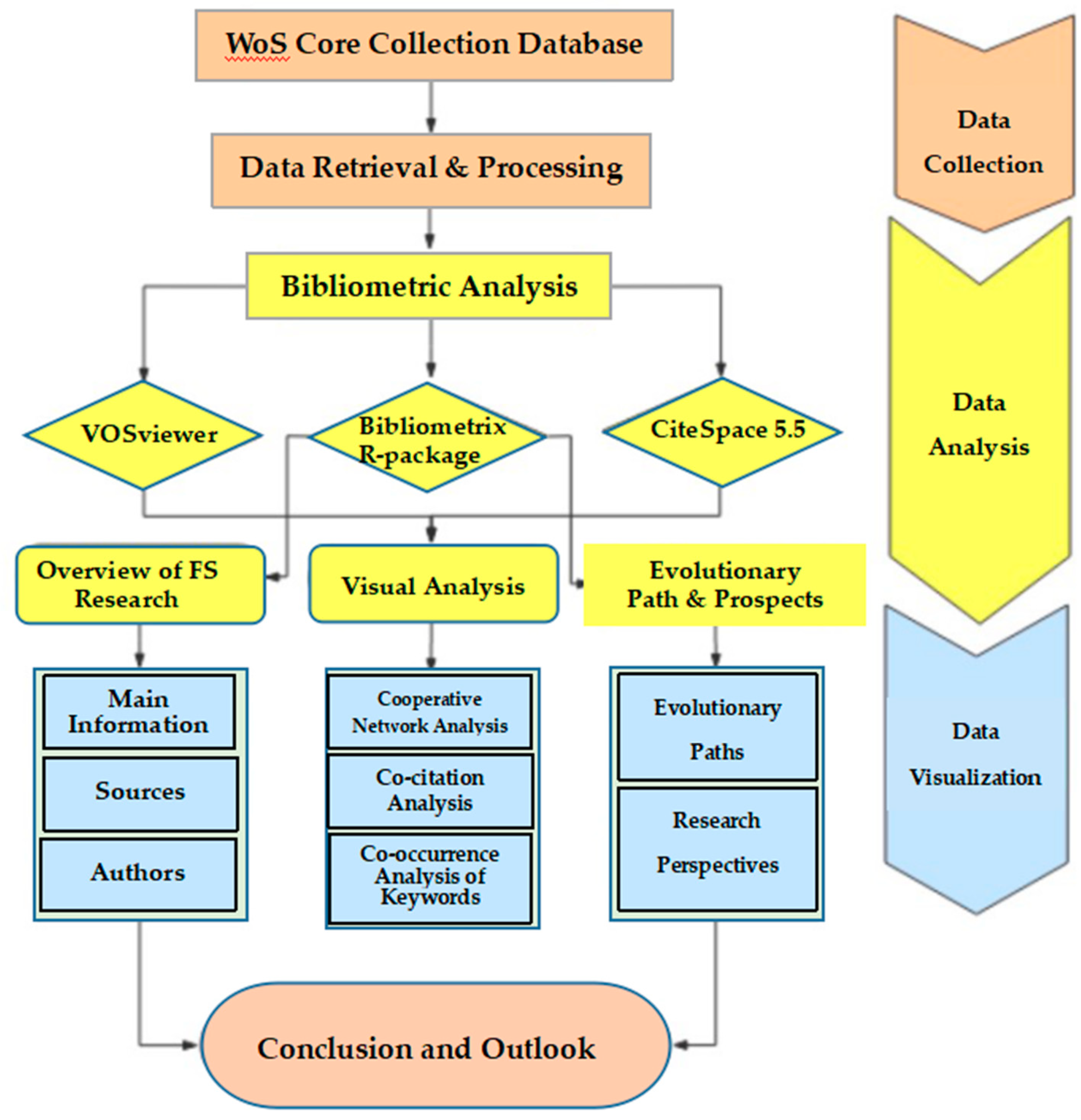
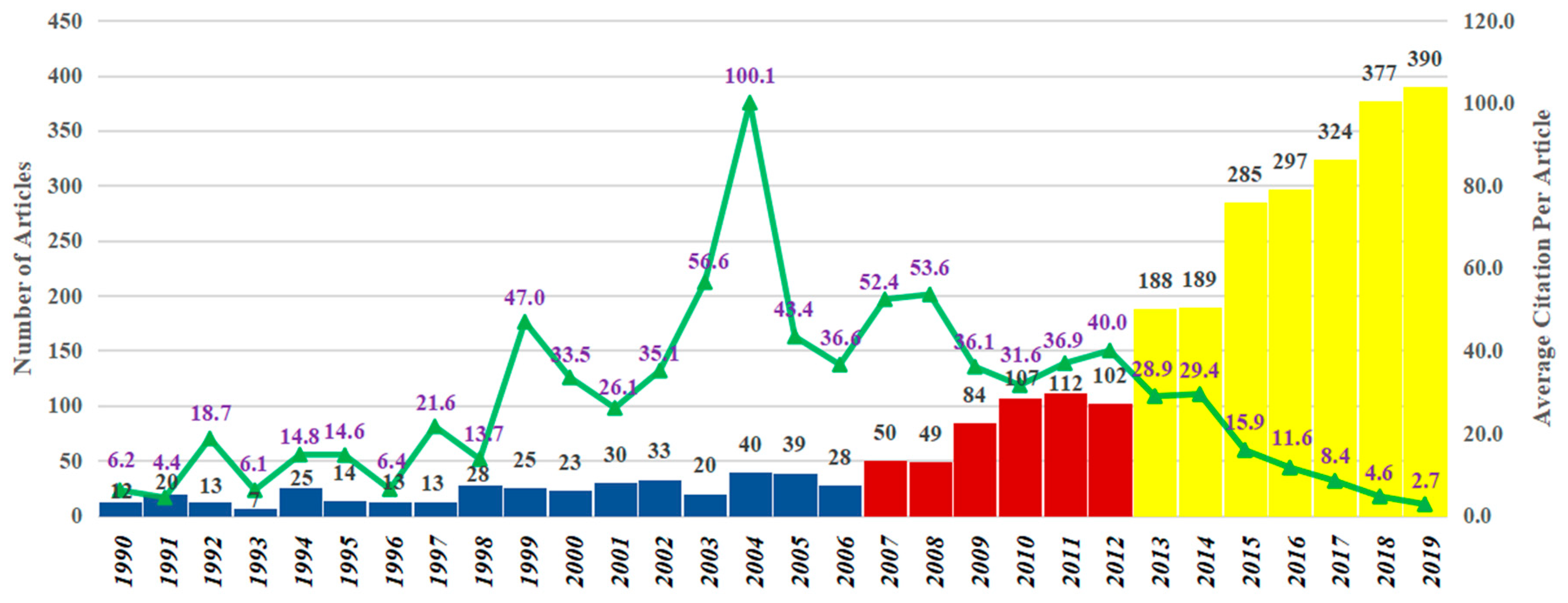
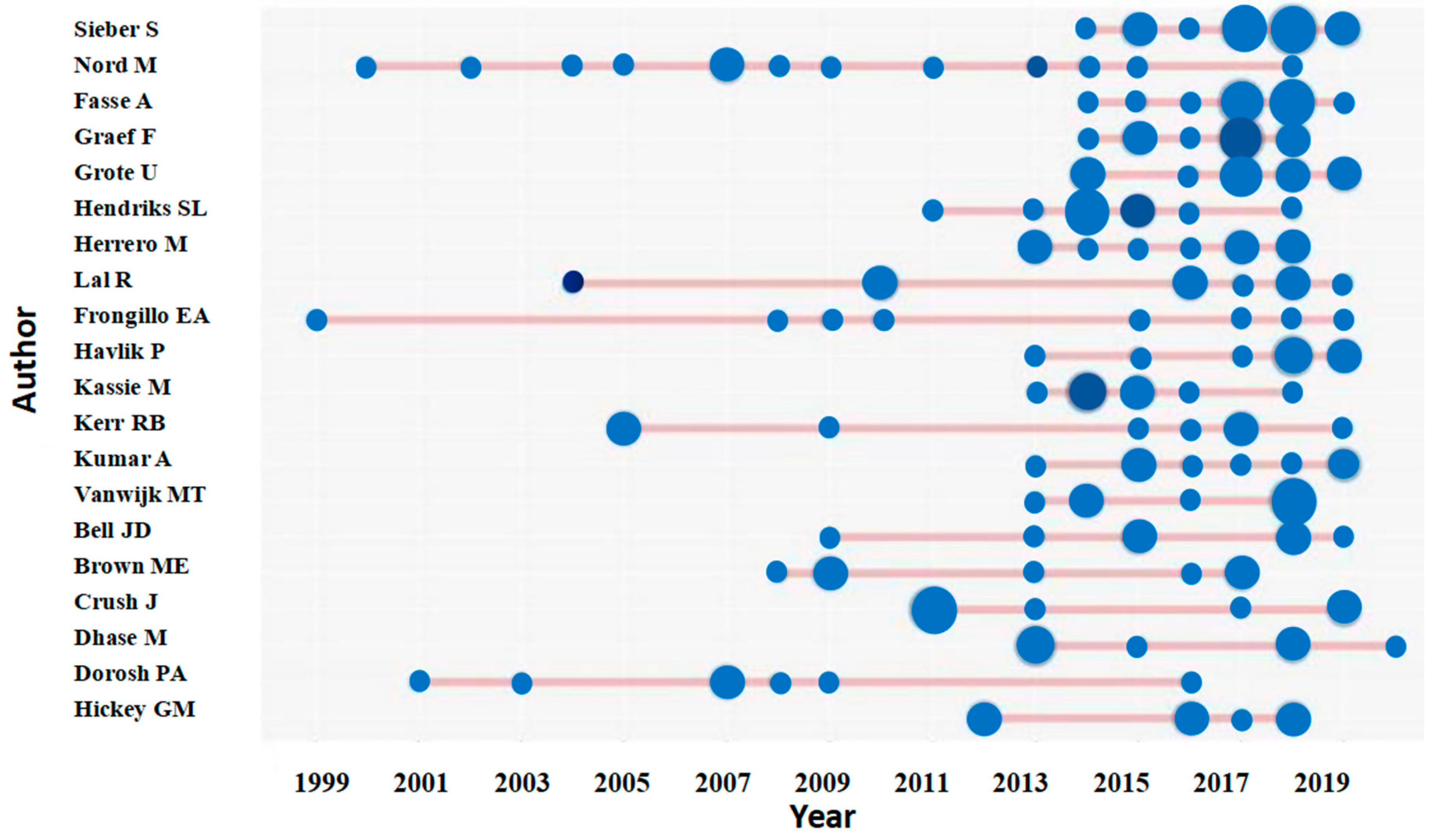

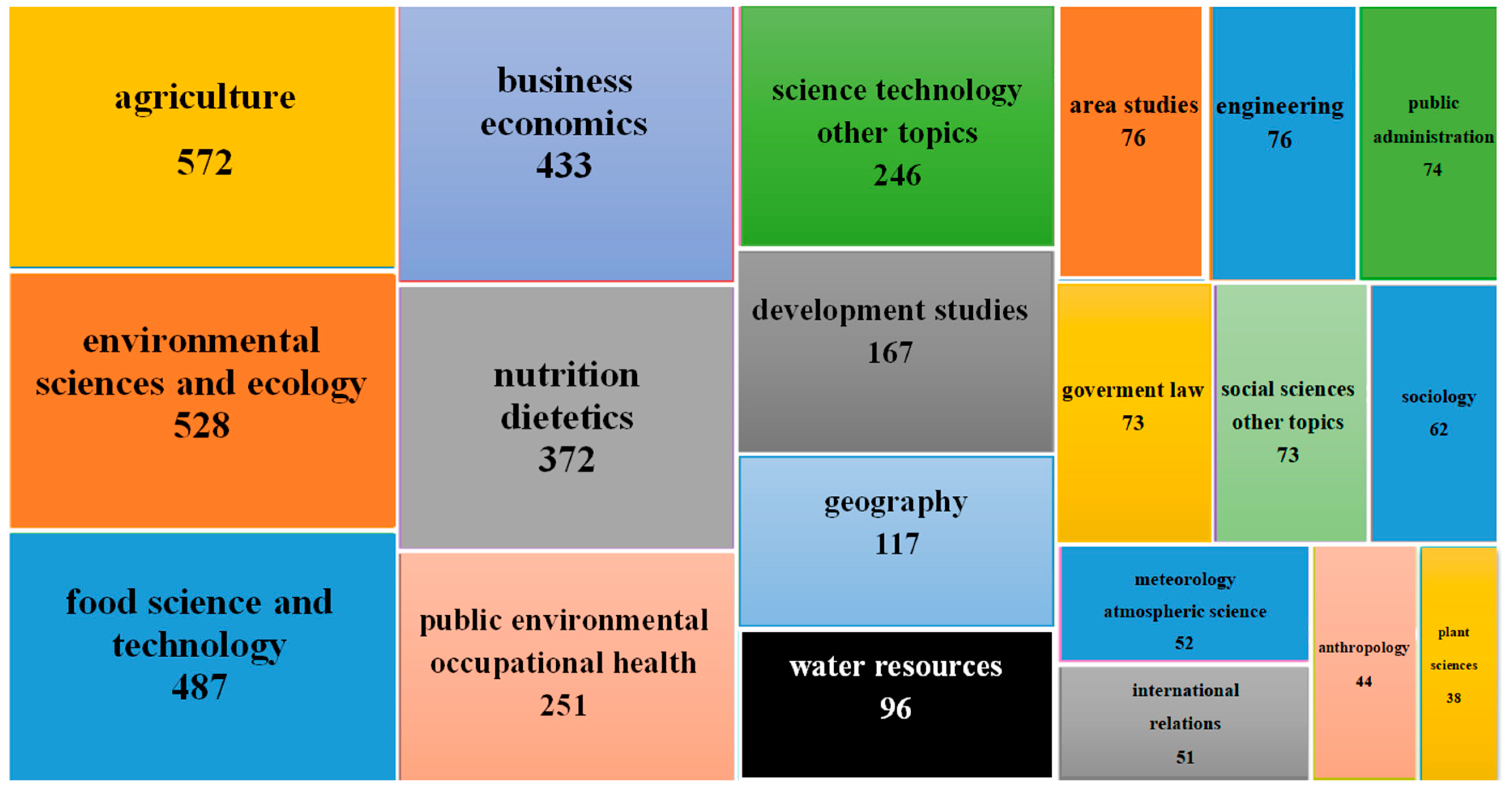
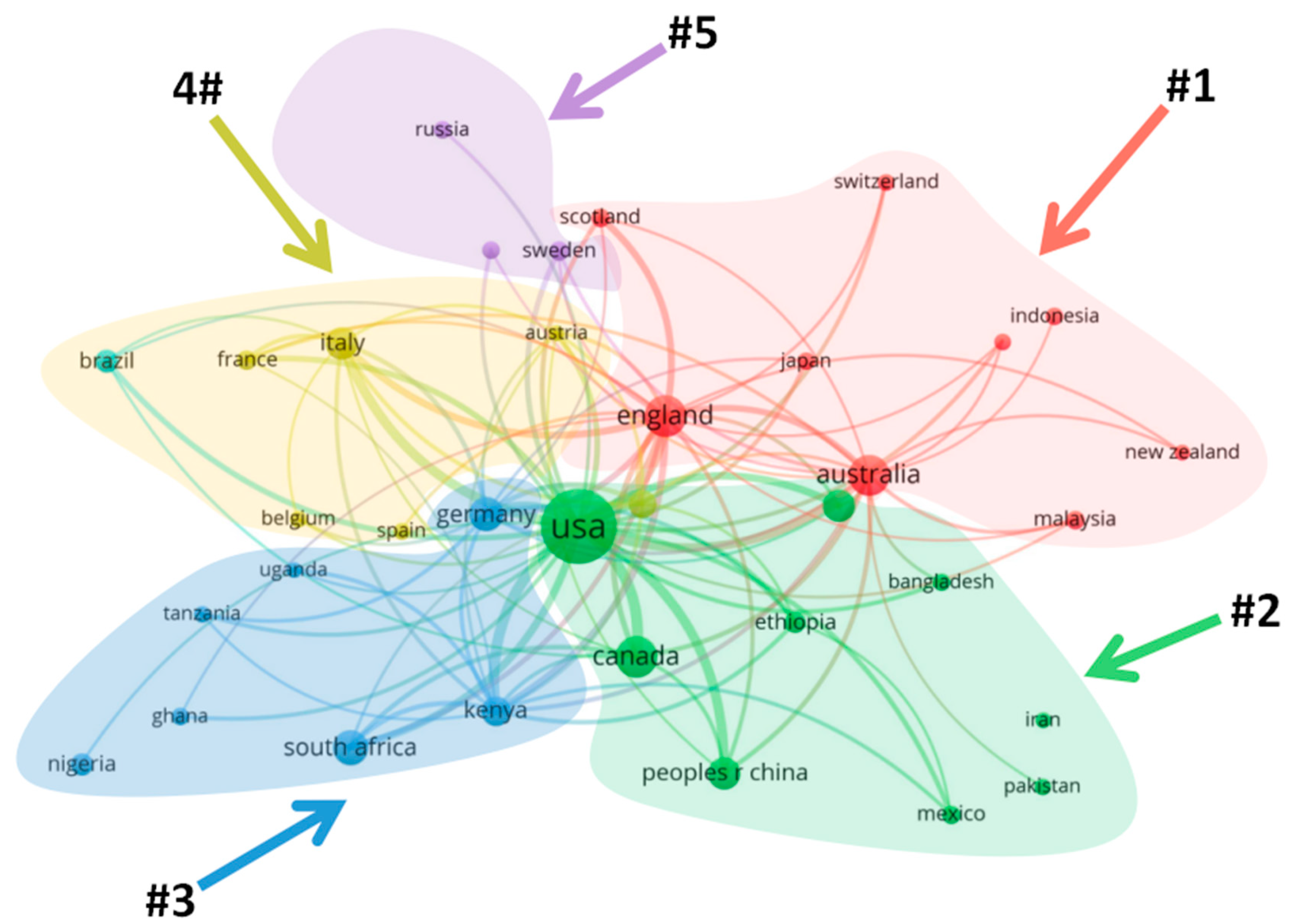
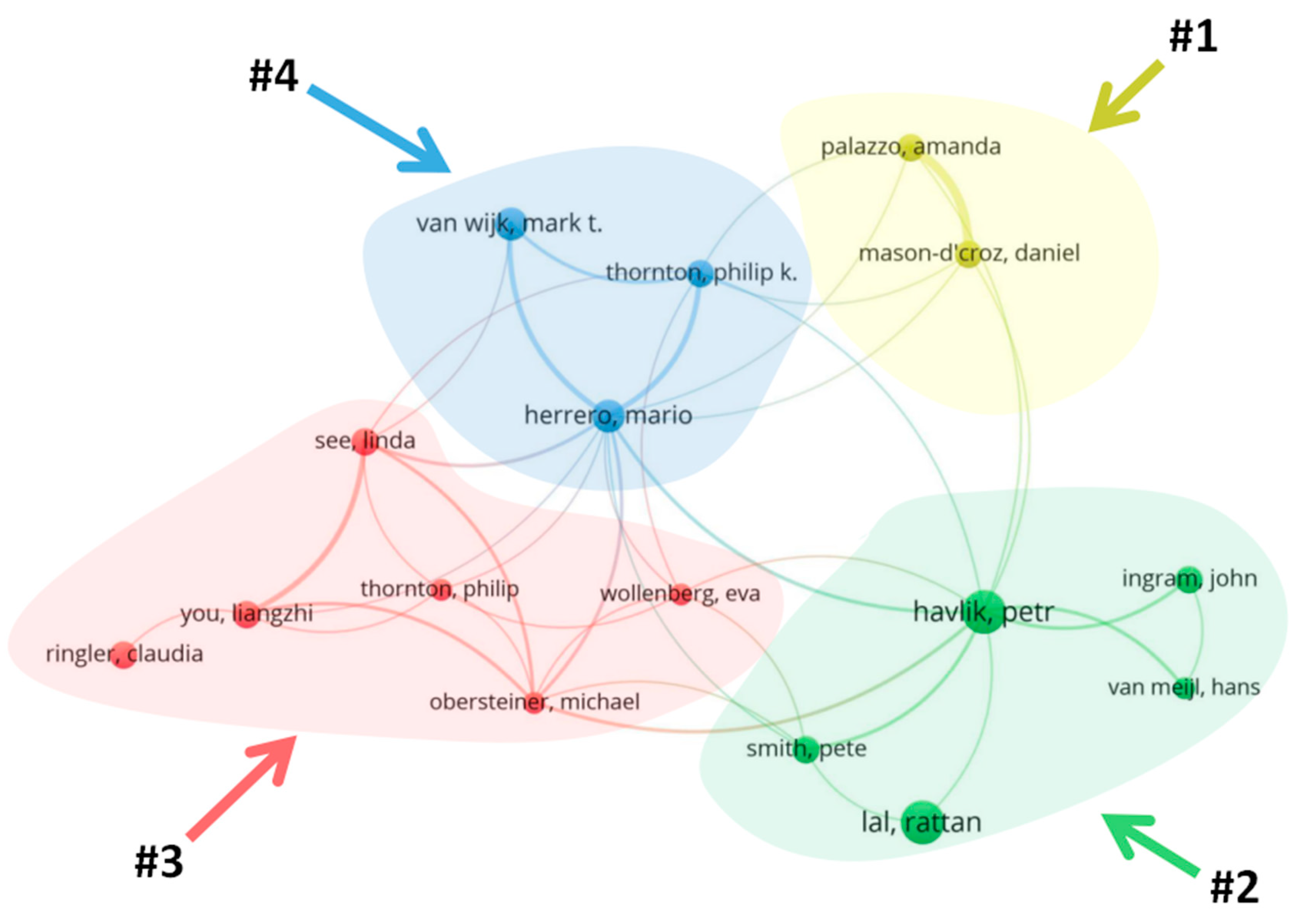
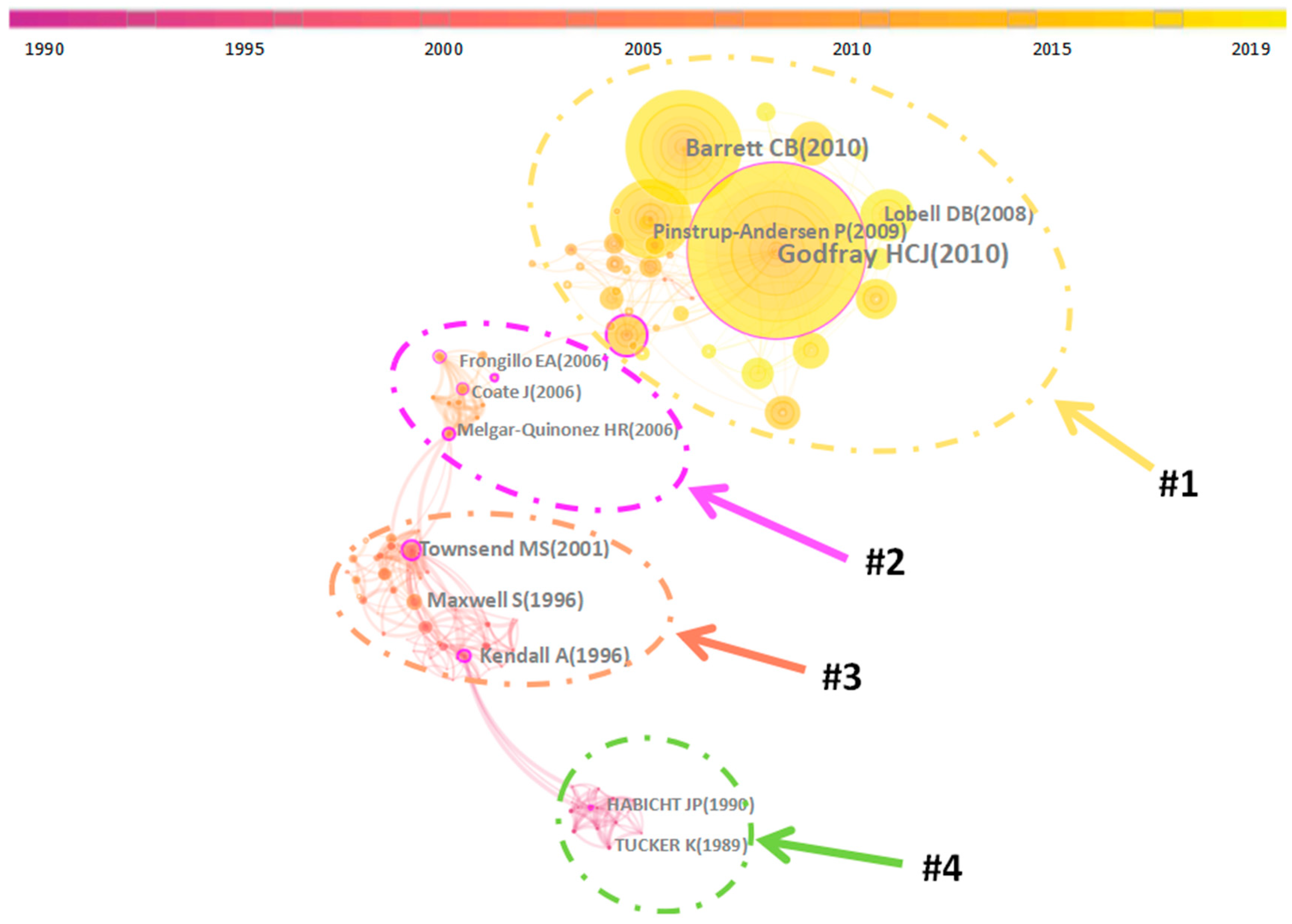
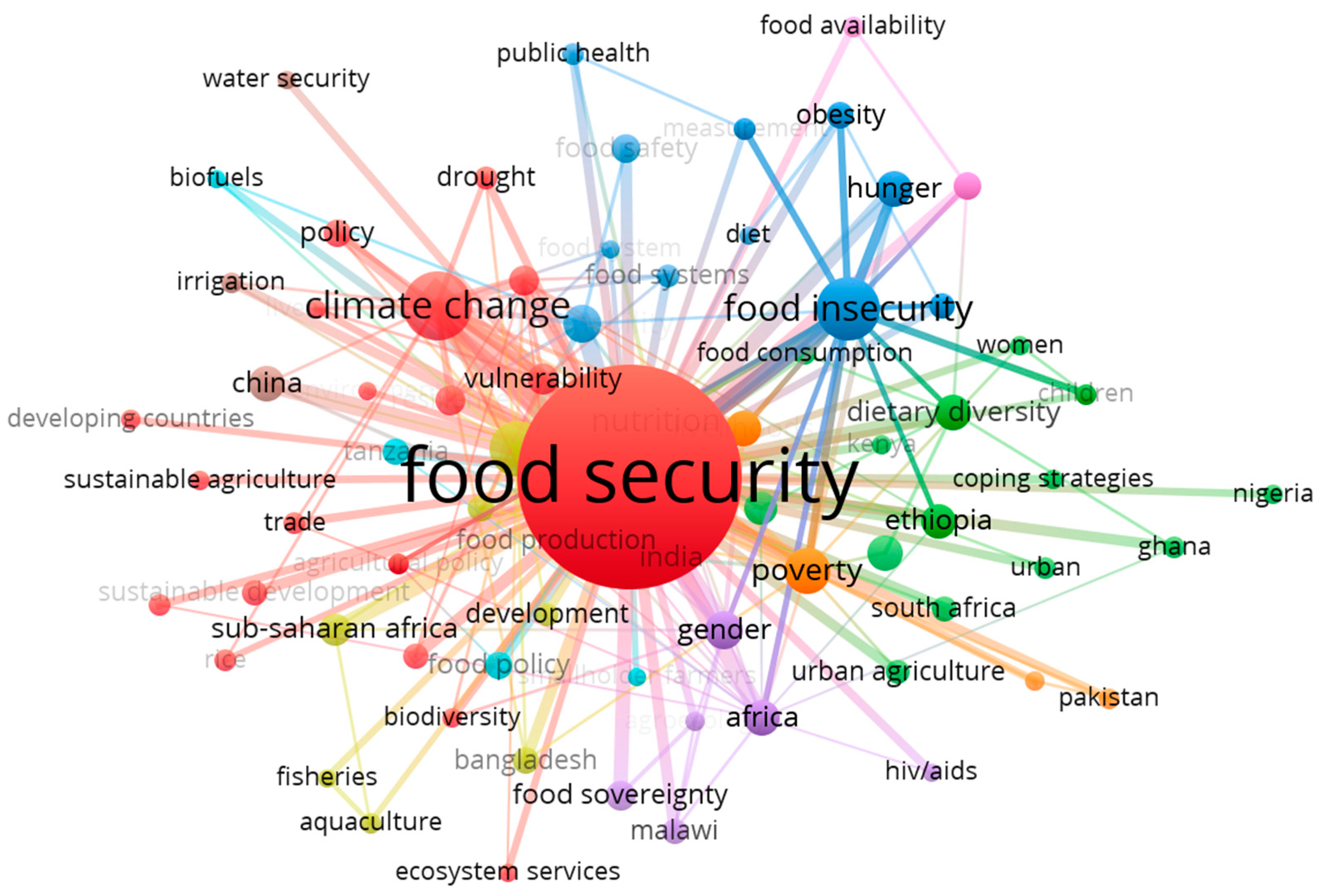
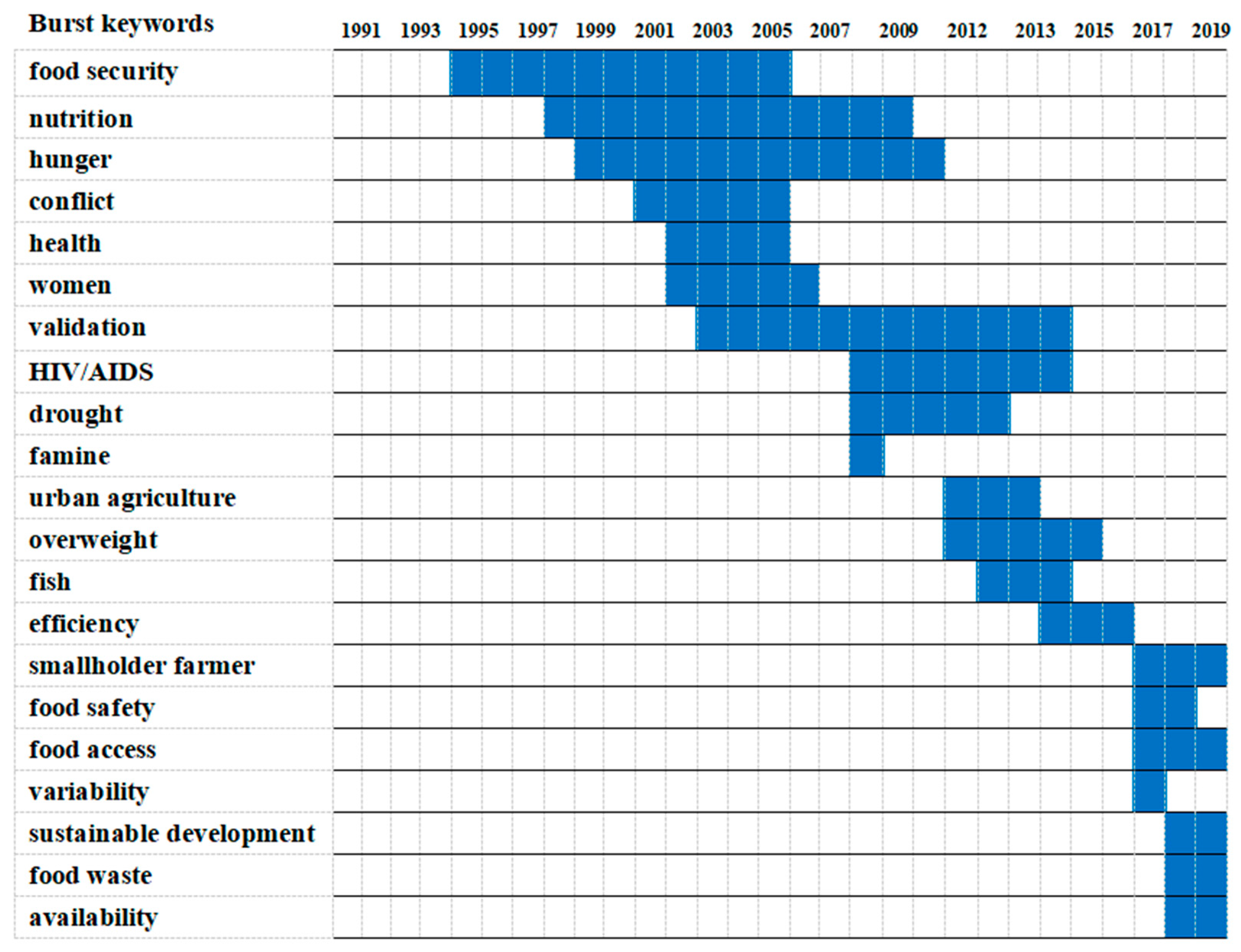

| Author | h-Index | TC | NP | PY_Start |
|---|---|---|---|---|
| Sieber S | 6 | 130 | 14 | 2014 |
| Nord M | 10 | 430 | 13 | 2000 |
| Fasse A | 6 | 120 | 12 | 2014 |
| Graef F | 6 | 128 | 10 | 2014 |
| Grote U | 6 | 129 | 10 | 2014 |
| Hendriks S | 5 | 75 | 9 | 2011 |
| Herrero M | 9 | 406 | 9 | 2013 |
| Lal R | 9 | 3412 | 9 | 2004 |
| Frongillo E | 6 | 310 | 8 | 1999 |
| Havlik P | 8 | 223 | 8 | 2013 |
| Region | Number of Articles | Total Citations | Average Citations Per Article |
|---|---|---|---|
| USA | 1952 | 21,878 | 11.2 |
| Canada | 486 | 3373 | 6.9 |
| UK | 464 | 5779 | 12.5 |
| Australia | 410 | 2728 | 6.7 |
| China | 346 | 3256 | 9.4 |
| South Africa | 277 | 1298 | 4.7 |
| Germany | 269 | 2391 | 8.9 |
| India | 226 | 899 | 4.0 |
| Italy | 210 | 3020 | 14.4 |
| Kenya | 182 | 1519 | 8.3 |
| Words | Occurrences | Words | Occurrences |
|---|---|---|---|
| food security | 1407 | India | 47 |
| climate change | 163 | hunger | 46 |
| food insecurity | 129 | livelihoods | 45 |
| nutrition | 98 | dietary diversity | 43 |
| poverty | 75 | Ethiopia | 43 |
| sustainability | 57 | food and nutrition security | 43 |
| Africa | 54 | policy | 41 |
| gender | 54 | sub-Saharan Africa | 40 |
| China | 53 | vulnerability | 39 |
| household food security | 49 | adaptation | 38 |
Publisher’s Note: MDPI stays neutral with regard to jurisdictional claims in published maps and institutional affiliations. |
© 2021 by the authors. Licensee MDPI, Basel, Switzerland. This article is an open access article distributed under the terms and conditions of the Creative Commons Attribution (CC BY) license (http://creativecommons.org/licenses/by/4.0/).
Share and Cite
Xie, H.; Wen, Y.; Choi, Y.; Zhang, X. Global Trends on Food Security Research: A Bibliometric Analysis. Land 2021, 10, 119. https://doi.org/10.3390/land10020119
Xie H, Wen Y, Choi Y, Zhang X. Global Trends on Food Security Research: A Bibliometric Analysis. Land. 2021; 10(2):119. https://doi.org/10.3390/land10020119
Chicago/Turabian StyleXie, Hualin, Yuyang Wen, Yongrok Choi, and Xinmin Zhang. 2021. "Global Trends on Food Security Research: A Bibliometric Analysis" Land 10, no. 2: 119. https://doi.org/10.3390/land10020119







